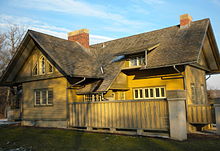George Fabyan
George Fabyan (born March 15, 1867 in Roxbury , Massachusetts , † May 17, 1936 in Geneva , Illinois ) was a successful American businessman who founded a private research institute called Riverbank Laboratories in the 1910s , which was among other things successful with cryptology concerned.
Life
He was born in Roxbury, the second of four children and the first son, a year before the city was incorporated into Boston in 1868 . His parents were George Francis Fabyan (1837–1907) and Isabel Frances Fabyan (1840–1909), b. Littlefield.
Fabyan was a very successful businessman who made a fortune from the textile trade inherited from his father. Around 1902 he married Wisconsin- born Nelle Wright. From around 1908, the couple lived in the Fabyan Villa (picture) , in the middle of the Riverbank Estate , an approximately 120 hectare property directly on the Fox River in northern Illinois.
Here he set up a private think tank for the purpose of researching various scientific and also pseudoscientific issues, the Riverbank Laboratories (picture) . He recruited personalities from industry and science and commissioned them to work on problems that interested him. This included very different areas such as acoustics , chemistry , genetics , cryptanalysis and literary studies .
A special task that particularly interested him was the subject of William Shakespeare authorship . The aim was to clarify the much discussed question of whether William Shakespeare (1564–1616) actually wrote the works ascribed to him himself. There were contemporaries who strongly doubted this. These suspected that they were in fact written by another author, possibly Francis Bacon (1561–1626), or even by several authors. George Fabyan was one of the skeptics . He suspected that the true author had hidden his name in the dramas or sonnets in encrypted form and could thus be identified.
Fabyan hired the young William Friedman (1891-1969), an immigrant from the Russian Empire , and in 1916 also the 24-year-old Elizebeth Smith (1892-1980) (see photo under web links ). Fabyan gave her the task of looking for the secret messages he suspected in Shakespeare's works. When preparing the Elizabethan texts in question (picture) , her young colleague Friedman from the genetics laboratory helped her to enlarge cryptic parts of the old documents with photos and then to analyze them. The two young researchers not only harmonized particularly well professionally, but also became closer privately and finally married in May 1917. Miss Smith became Mrs. Elizebeth Friedman. Together they later became the most famous cryptologist couple in American history.
After the United States entered the First World War , the laboratory began to work intensively and successfully with cryptanalysis and deciphered encrypted messages from the Central Powers and Mexico from autumn 1917 . American officers were also trained in cryptology here.
The Riverbank Laboratories , founded by George Fabyan, are now considered the birthplace of American cryptology. In 1992, his services were officially recognized posthumously and a plaque was unveiled in his honor at this location: “To the Memory of George Fabyan From a Grateful Government” ( German “To commemorate George Fabyan from a grateful government” ).
He was 69 years old and was laid to rest in Forest Hills Cemetery , a park cemetery in the Forest Hills , an area in the Jamaica Plain district of his hometown . His gravestone has been preserved (see web links ).
Fonts (selection)
- What I Know About the Future of Cotton and Domestic Goods. Self-published in 1900.
literature
- Friedrich L. Bauer : Deciphered Secrets. Methods and maxims of cryptology. 3rd, revised and expanded edition. Springer, Berlin a. a. 2000, ISBN 3-540-67931-6 .
- Rudolf Kippenhahn: Encrypted messages, secret writing, Enigma and chip card . Rowohlt, Reinbek bei Hamburg 1999, p. 44. ISBN 3-499-60807-3 .
- Fred B. Wrixon: Codes, Ciphers & Other Secret Languages - From Egyptian Hieroglyphics to Computer Cryptology . Könemann, Cologne 2000. ISBN 3-8290-3888-7 .
Web links
- Portrait photo
- Photo of George Fabyan with Elizebeth Smith in the summer of 1916 on the Riverbank Laboratories site at MarshallFoundation.org
- Short CV at Money.CNN.com
- George Fabyan Collection at LoC.gov
- His tombstone at FindAGrave.com
Individual evidence
- ↑ FindAGrave.com , accessed August 16, 2019.
- ^ Rudolf Kippenhahn: Encrypted messages, secret writing, Enigma and chip card . Rowohlt, Reinbek bei Hamburg 1999, p. 44. ISBN 3-499-60807-3
- ↑ Friedrich L. Bauer: Deciphered secrets. Methods and maxims of cryptology. 3rd, revised and expanded edition. Springer, Berlin et al. 2000, p. 32.
- ↑ Fred B. Wrixon: Codes, Ciphers & Other Secret Languages - From Egyptian Hieroglyphics to Computer Cryptology . Könemann, Cologne 2000, pp. 595-596. ISBN 3-8290-3888-7 .
| personal data | |
|---|---|
| SURNAME | Fabyan, George |
| BRIEF DESCRIPTION | American entrepreneur |
| DATE OF BIRTH | March 15, 1867 |
| PLACE OF BIRTH | Roxbury (Boston) |
| DATE OF DEATH | May 17, 1936 |
| Place of death | Geneva , Illinois |


